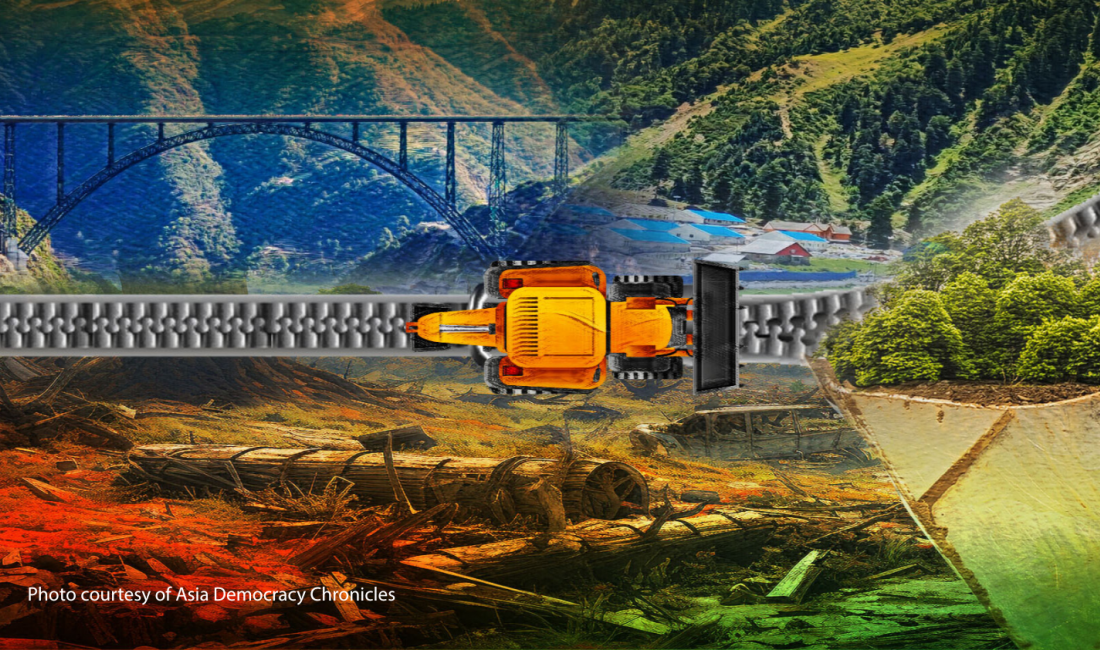Questions about the Infrastructure Being Built Since Kashmir Lost Autonomous Status in 2019
This piece is republished from Asia Democracy Chronicles.
As the road in a remote village in India-administered Kashmir comes to an end, one is greeted by a stunning green and black structure of steel, its graceful pillars standing firmly between two Himalayan mountains, and its wide arch looking like a giant crown for the mighty Chenab River rushing some 366 meters below it.
Located in Kashmir’s Reasi district, the mammoth Chenab Railway Bridge took nearly two decades to build, with over 1,500 workers and engineers toiling around the clock in unforgiving conditions. It is part of the Udhampur-Srinagar-Baramulla Railway Link (USBRL) that Indian officials say will become a reliable all-weather transportation system between Kashmir and the rest of India. India has also built 38 tunnels with a combined length of 118 km for the line.
Known for its breathtaking scenery, Kashmir in the last several years has had many areas covered in dust and gravel as the region gained more infrastructure projects. From roads to bridges, to hydropower projects, Kashmir has been having a continuous infrastructure fever that Union officials say will bring development and prosperity to the region.
Speaking last January at the inauguration of the Z-Morh Tunnel in Sonamarg, a hill station in Kashmir, Prime Minister Narendra Modi said that Jammu and Kashmir “is becoming a hub of tunnels, bridges, and ropeways.” He said that “the world is in awe after seeing the engineering of Chenab Bridge” and that the Z-Morh Tunnel “is a game changer that will boost tourism and provide new opportunities for the people.”
There is another reason for the central government’s desire to improve its connectivity to the rest of the country: to move troops more efficiently in what is already one of the world’s most militarized zones. In recent years, at least 15 road tunnels have been built in strategic spots in Kashmir, and more are bound to be constructed.
But these and other new and upcoming infrastructures are failing to impress many geologists and ecologists. In fact, they agree with activists who point out that the projects have meant blasting hillsides, drilling tunnels, and deforestation – all of which exacerbate the region’s pre-existing ecological weaknesses and worsen its ecological crisis.
“The implications of these projects are quite severe,” said an expert on earth sciences who asked to remain anonymous. “They have worsened environmental vulnerabilities and caused damage that may be nearly impossible to reverse.”
He agreed with a Kashmir-based geologist that the extensive excavation in the fragile Himalayan mountains of Kashmir for the railway system alone could lead to “catastrophic destruction” if environmental concerns associated with it are not addressed. Another important issue that officials seem to be ignoring is that Kashmir is located in the northwestern Himalayas, which is one of the world’s most active seismic regions and has a history of earthquakes.
“Kashmir’s mountains are mostly dotted with faults, which make them extremely fragile. Blasting, use of heavy machinery, and unplanned excavation disturbs these faults and increases the risk of disasters,” said the geologist.
Another geologist explained that excavation in Kashmir’s mountains triggers “isostatic uplift.” This means that when material is removed, the earth shifts to balance the loss, activating hidden faults. “Once this environment is disturbed, it takes millions of years to recover,” the geologist warned
Repeatedly “reopening wounds”
Some impacts are already being felt. On Feb. 19 2023, for instance, a crater tore through 500 meters of Dalwah village, a hamlet about 200 kms from Srinagar, the summer capital in Jammu and Kashmir. During the next three days, 16 houses succumbed to land subsidence while several others became unlivable. The tragedy also eventually rendered the village’s agricultural land, on which many of the residents were dependent for their livelihood, useless.
“About 7,000 villagers now live in fear of another calamity,” said Mohammed Raqeeb Wani, a former elected representative of Dalwah, which covers about 1,000 households. “The railway tunnels have made the village unsafe.”
Of the 38 tunnels built for the USBRL project, three are near Dalwah. Wani believes the February 2023 incident was caused by the tunnel construction downhill. “The blasting has loosened the soil, making the mountains unstable,” he said. “Before this project, we never had such disasters.”
Even houses that had not been damaged two years ago have now started to show cracks, Wani said. “Despite this, the government wants to carve out a fourth tunnel,” he said. “I do not know when, but [tunnels] will soon lead to a catastrophe.”
In truth, it was not the first time that railway construction was among the factors causing a tragedy in Dalwah. In September 2010, a landslide left at least 50 houses in the village – along with a mosque and other buildings – damaged or completely destroyed. Researchers from the University of Jammu later determined heavy rainfall and the topography itself as two of the major causes of the landslide, but they also listed “the interference of men and heavy earth-moving machines for railway track construction and approach road close to the unstable zone” as “contributory factors.”
Dr Abdullah Ansari, a research professor at the Earthquake Monitoring Center, Sultan Qaboos University Oman, compared tunnel excavation in Kashmir to reopening a wound repeatedly. “Development in Kashmir is necessary, but not at the cost of the environment,” he told Asia Democracy Chronicles. “What is happening is that this fragile mountain is being dug using tunnel boring machines that go as deep as five meters. However, the impact isn’t limited to that area; it can spread to areas up to 30 km away, potentially causing land subsidence.”
Changing ecology
Yet it’s not only tunnels, bridges, roads, and railways that are causing experts and environmentalists worry in Kashmir. Hydropower projects have also become popular in the region, with Chenab Valley alone having eight major projects that are either completed or under construction.
While these projects aim to boost India’s renewable energy output, experts say that the environmental costs have largely been overlooked.
“The disaster potential of this area essentially increases once these major interventions are imposed,” said Himanshu Thakkar, coordinator of the South Asian Network on Dams, Rivers and Peoples, an informal network that advocates for issues related to dams, rivers, and water infrastructure in India. “Wherever hydropower projects are constructed, the ecology changes.”
According to a 2017 study assessing small hydropower projects in the region pointed out, since these infrastructure projects “are located in the remote areas of (Jammu and Kashmir) their construction activity have the negative effect on the agriculture and forest land, and also on the local infrastructure of the region where these projects are installed.”
It highlighted as well the adverse effect of such undertakings on the local aquatic life.
“As a result of the modification of riverine conditions to lacustrine habitats, the macro-benthic life is perhaps the worst affected,” the study said. It adds that unprotected borrow pits and muck disposal sites “may lead to increased soil erosion and sedimentation problems on the downstream side of the river.”
Experts also warn that many of these dams are built at or near fault lines, making them more vulnerable to disasters. At the same time, these hydropower projects themselves have been linked as among the causes of landslides in the area.
In February 2009, a massive landslide washed out a stretch of nearly 150 meters of a key road in the region. According to a 2012 study, the landslide was connected to the reservoir of the Baglihar dam in Chenab Valley.
Problems beget problems
Making matters worse is that the infrastructure push is driving illegal and unregulated riverbed mining for minerals, which in turn has led to environmental fallouts such as changes in river morphology, riverbank erosion, and water pollution.
A 2023 report by the regional government’s Department of Ecology, Environment, and Remote Sensing said that the boom in infrastructure projects is the chief reason why demand for minor minerals and building materials has “enormously” increased, putting “immense pressure on rivers.”
Official data show that between fiscal years 2021-22 and 2022-2023, Kashmir’s mineral production rose from six million metric tons to 12.1 million metric tons. Meanwhile, annual sand and riverbed mining records reveal that in the fiscal year 2021-22, a total of 474,000 metric tons of materials were extracted from local riverbeds. In 2022-23, the quantity of material mined more than doubled, with 1.142 million metric tons of material extracted.
Environmentalist Dr. Raja Muzaffar Bhat told ADC that before mechanized mining began, rivers followed a set course, nourishing paddy fields, apple orchards, and vegetable farms through small irrigation channels. Today, he said, “mining that may reach depths of 30 feet (9.14 meters) causes the river level to drop, preventing water from reaching the vegetation and causing farmlands and tube wells to dry up. This could spell massive trouble for Kashmir.”
Yet even more trouble may be coming as Kashmir’s tourist numbers keep ramping up, in large part due to the improved road-and-railway system.
While a rise in tourists can boost the local economy, sociologists Subhat Dagga and Dr. Abhilasha Pathak argue that the “manifold increasing” tourism in the region has put “mounting pressure on the environment.”
“As long as the tourist traffic was within the carrying capacity of the mountains, no sign of adverse ecological effects were tangible,” Dagga and Pathak said in a 2022 paper. “However, now with a sea change in the situation, the mountain environment has been adversely affected by tourist activities and it is already showing signs of virtual collapse.”



